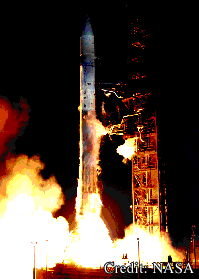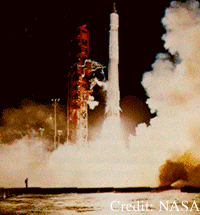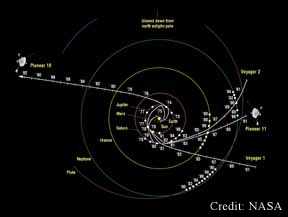
Pioneer 10 & 11Pioneer 10 & 11
Summary: The Pioneer missions were the first to send spacecrafts through the asteroid belt and the first to send detailed, up-close images of Jupiter and Saturn back to Earth.
Pioneer 10

Pioneer Launch
- Launch Date: 2 March 1972
- Mission: Explore the Asteroid belt and Jupiter
- Arrived at Jupiter: December 1973
- Last Signal Received: 23 January 2003
- Final Attempt at Contact: 4 March 2006
Pioneer 10 was the first spacecraft to travel through the Asteroid belt and the first to make direct observations of an outer planet. Pioneer 10's mission was to study Jupiter's atmosphere, magnetosphere and satellites, particularly Io, as well as solar wind parameters and dust distribution.
Both Pioneer spacecraft were fitted with identical gold plaques intended to serve as messages for extraterrestrial life. The plaque includes a drawing of a man, a woman, and the location of the Sun and the Earth in the Milky Way Galaxy.
LEARN MORE ABOUT THE PIONEER PLAQUES
The historic flyby of Jupiter opened the gate for future outer planet exploration. After Pioneer 10 flew by Jupiter in 1973 it began its journey towards the star Aldebaran. ETA: 2 million years. Until the Voyager 1 spacecraft passed the record in 1998, Pioneer 10 was the most distant human-made object in the solar system.
PIONEER 11

Pioneer 11 Launch
- Launch Date: 5 April 1973
- Jupiter Flyby: 2 December 1974
- Saturn Flyby: 1 September 1979
- Contact Lost: November 1995
Launched over a year after its sister spacecraft, Pioneer 11 was the second spacecraft to explore the outer solar system. The spacecraft used Jupiter for a gravitational assist to slingshot it out to Saturn. Pioneer 11 studied the masses, interiors, atmospheres, moons and rings of Jupiter and Saturn.

The Great Red Spot taken
by Pioneer 11 in 1974
During its flyby of Jupiter in 1974, Pioneer 11 made some amazing discoveries. Close-ups of the planet provided the first observations of the polar regions, as well as some clear images of the Great Red Spot. It also provided an accurate mass of Jupiter's moon Callisto.
CLICK FOR MORE OF PIONEER 11'S JUPITER PICS
After gaining some momentum from the Jupiter flyby, Pioneer 11 arrived at Saturn 5 years later. By this time, Voyager 1 and 2 were en route to Saturn as well. As the first spacecraft to make direct observations of the ringed planet, Pioneer 11 was truly acting as a "pioneer", paving the way for the following spacecraft. Practically colliding with one of Saturn's moons on approach, Pioneer 11's mission was to survey the rings and moons surrounding Saturn to ensure safety for the Voyager spacecrafts.

Pioneer image of Saturn
taken in 1979 showing
the satellite Rhea
Pioneer 11 discovered a small moon and an additional ring around Saturn. The spacecraft traveled underneath the ring plane taking beautiful pictures of Saturn's rings. It also took measurements of Saturn's magnetosphere, magnetic field and largest moon, Titan. Much to our dismay, Pioneer 11 sent back information showing that Titan is too cold to sustain life.
CLICK FOR MORE OF PIONEER 11'S SATURN PICSBoth Pioneer 10 and Pioneer 11 were equipped with plaques intended to serve as messages from humankind. The plaques include a drawing of a man, a woman, and the location of the Sun and Earth in the Milky Way galaxy.

Pioneer trajectories shown
throughout the solar system
After leaving Saturn, Pioneer 11 was placed on a trajectory that would send it flying out of the solar system. The last communication with Pioneer 11 was in November 1995, though scientists say the spacecraft has yet to leave the heliosphere.
MORE ABOUT THE PIONEER PROJECT
The official Pioneer Project site at NASA
More info about the gold plaques on the Pioneer spacecraft


